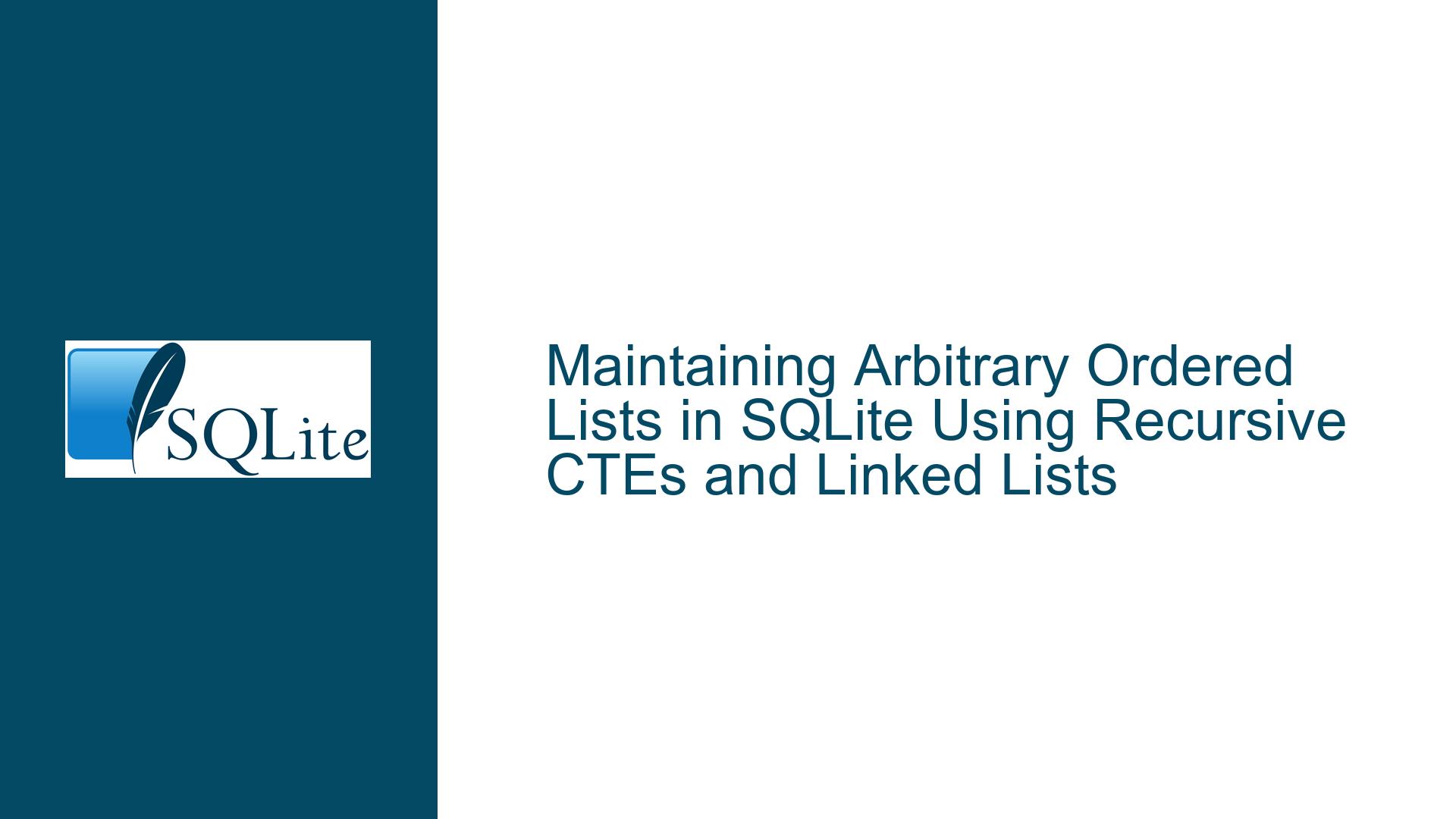Maintaining Arbitrary Ordered Lists in SQLite Using Recursive CTEs and Linked Lists
Implementing a Linked List Structure for Arbitrary Ordering in SQLite
When working with SQLite, maintaining an arbitrary order for a list of items can be challenging, especially when the order is not based on a natural sorting key like alphabetical order or numerical value. The core issue revolves around how to insert new items into the list at specific positions without having to renumber the entire list, which can be computationally expensive and error-prone. The solution lies in implementing a linked list structure within the database, where each item points to the previous item in the sequence. This approach allows for efficient insertions and deletions while maintaining the desired order.
To achieve this, we create a table where each row contains a unique identifier (row_id), the item itself (item), and a reference to the previous item in the sequence (prev). The prev column acts as a pointer to the row_id of the previous item, effectively creating a chain of references that defines the order of the list. The first item in the list points to a special value, typically 0, indicating that it has no predecessor.
Here’s the schema for such a table:
CREATE TABLE list (
row_id INTEGER PRIMARY KEY,
item TEXT UNIQUE,
prev INTEGER REFERENCES list(row_id) DEFERRABLE INITIALLY DEFERRED
);
In this schema, row_id is an auto-incrementing primary key that uniquely identifies each row. The item column stores the actual data, and the prev column stores the row_id of the previous item in the sequence. The DEFERRABLE INITIALLY DEFERRED clause ensures that foreign key constraints are checked at the end of the transaction, allowing for more flexible updates.
To insert items into the list, we use a combination of INSERT and UPDATE statements within a transaction. For example, to insert an item "p" after item "t", we first insert "p" with its prev value set to the prev value of "t". Then, we update the prev value of "t" to point to the newly inserted "p". This ensures that the linked list remains consistent.
BEGIN TRANSACTION;
INSERT INTO list VALUES (NULL, "p", (SELECT prev FROM list WHERE item = "t"));
UPDATE list SET prev = (SELECT last_insert_rowid()) WHERE item = "t";
COMMIT;
This approach allows us to insert items at any position in the list without having to renumber the entire list. However, querying the list in the correct order requires a recursive Common Table Expression (CTE) to traverse the linked list.
Recursive CTEs for Traversing Linked Lists in SQLite
To retrieve the list in the correct order, we need to traverse the linked list starting from the first item (where prev = 0) and follow the chain of prev references. This is where recursive CTEs come into play. A recursive CTE allows us to perform a recursive query, which is essential for traversing the linked list.
Here’s how the recursive CTE works:
- The base case of the recursion selects the first item in the list, where
prev = 0. - The recursive part of the CTE joins the current result set with the
listtable on the condition that theprevcolumn of thelisttable matches therow_idof the current result set. - The recursion continues until there are no more items to join, effectively traversing the entire linked list.
The following query demonstrates how to use a recursive CTE to retrieve the list in the correct order:
WITH RECURSIVE ordered AS (
SELECT *
FROM list
WHERE prev = 0
UNION ALL
SELECT list.*
FROM list
JOIN ordered ON list.prev = ordered.row_id
)
SELECT * FROM ordered;
In this query, the ordered CTE starts by selecting the first item in the list (where prev = 0). Then, it recursively joins the list table with the ordered CTE, following the chain of prev references. The final SELECT statement retrieves the entire list in the correct order.
To optimize this query, it’s recommended to create an index on the prev column. This index will speed up the joins in the recursive part of the CTE, making the query more efficient, especially for large lists.
CREATE INDEX idx_list_prev ON list(prev);
Handling Edge Cases and Optimizing List Operations
While the linked list approach with recursive CTEs is powerful, it’s important to handle edge cases and optimize list operations to ensure robustness and performance. One common edge case is inserting an item at the beginning or end of the list. For example, inserting an item at the beginning of the list requires updating the prev value of the current first item to point to the new item, and setting the prev value of the new item to 0.
Here’s how to insert an item "w" at the beginning of the list:
BEGIN TRANSACTION;
INSERT INTO list VALUES (NULL, "w", (SELECT prev FROM list WHERE item = "b"));
UPDATE list SET prev = (SELECT last_insert_rowid()) WHERE item = "b";
COMMIT;
Similarly, inserting an item at the end of the list requires setting the prev value of the new item to the row_id of the current last item. This can be done using the MAX function to find the row_id of the last item.
INSERT INTO list VALUES (NULL, "h", (SELECT MAX(row_id) FROM list));
Another important consideration is the performance of list operations, especially for large lists. While the recursive CTE is efficient for traversing the list, frequent insertions and deletions can lead to fragmentation in the prev references, potentially slowing down queries. To mitigate this, periodic maintenance operations such as renumbering the row_id values can be performed. However, this should be done with caution, as it can be computationally expensive and may require locking the table.
In conclusion, maintaining an arbitrary ordered list in SQLite using a linked list structure and recursive CTEs is a robust and efficient approach. By carefully handling edge cases and optimizing list operations, you can ensure that your list remains consistent and performant, even as it grows in size and complexity.






